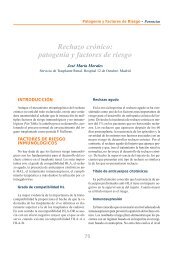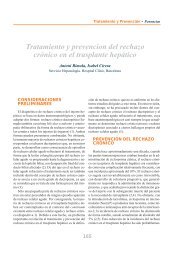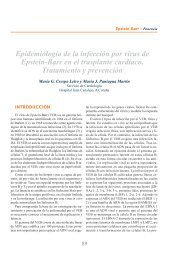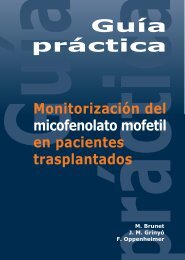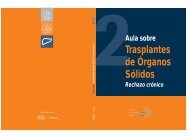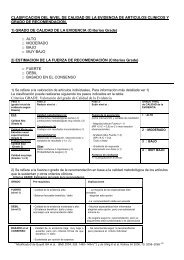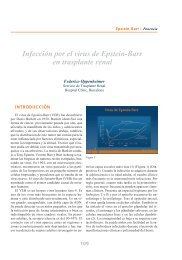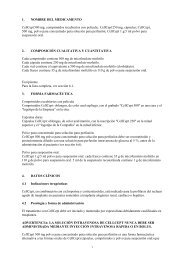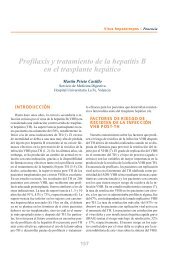Untitled - Roche Trasplantes
Untitled - Roche Trasplantes
Untitled - Roche Trasplantes
You also want an ePaper? Increase the reach of your titles
YUMPU automatically turns print PDFs into web optimized ePapers that Google loves.
EARLY DIAGNOSIS OF CHRONIC ALLOGRAFT NEPHROPATHY<br />
BY MEANS OF PROTOCOL BIOPSIES<br />
anti-Il2 receptor antibody (51). An alternative strategy has been studied since the early<br />
1980’s, notably early conversion from a calcineurin inhibitor based regimen to one which<br />
eliminates the CNI after three, six or twelve months. It is not in the scope of this chapter<br />
to identify and review these studies which others have accomplished in formal metaanalyses<br />
(52, 53), but it is important to note that one of the more recent studies using<br />
sirolimus and corticosteroids as maintenance therapy was accompanied by protocol<br />
biopsies (54). In this study biopsies at implantation, 12 and 36 months were studied in<br />
a subset of patients that provided biopsy material at each time point. The most interesting<br />
feature of this study was that the group in which the CNI was eliminated had<br />
resolution of tubular atrophy between 12 and 36 months, without increased interstitial<br />
fibrosis. Thus the total CADI index of chronic damage was unchanged in the sirolimus<br />
treated patients, suggesting that the strategy might hold out some hopes for long term<br />
improvement in CAN, if effective and applicable clinical regimens can be developed to<br />
avoid the CNI’s.<br />
Future opportunities<br />
Clearly, very early diagnosis of events that may subsequently damage the graft might<br />
increase the effectiveness of interventions. The possibility that gene events will predict<br />
histology has been borne out in early studies from a number of groups including our<br />
own. Vitalone at the World Transplant Congress in Boston in July 2006 (55), presented<br />
data derived from Gene Microarrays demonstrating that genes associated with both<br />
CAN and rejection “turn on” –i.e., produce mRNA– earlier than the histological changes<br />
were apparent. If this is borne out in other laboratories and in other series of patients,<br />
it may offer a way of predicting the patients in whom intervention would be especially<br />
valuable.<br />
SUMMARY<br />
Chronic Allograft Nephropathy is the syndrome that has come to plague renal transplantation<br />
as the cause of most graft losses. It has been evident for as long as we have been<br />
transplanting the kidney, but in the early days it was overshadowed by acute rejection<br />
and mis-interpreted as an entirely immune related phenomenon termed “chronic rejection”.<br />
It has been the source of most concern to clinical transplant programs for the past<br />
ten years, but the long term nature of the syndrome has meant that it has not been an<br />
easy target for research. Paradoxically, the pharmaceutical industry –which has the most<br />
to gain from long term use of particular agents– is most unlikely to fund the research trials<br />
that we will need to prove which are the best treatment options. Long term investments<br />
in this area are likely to be superseded before they have produced any answers. We are<br />
thus left with the individual transplant centre studies, implied answers from long term<br />
cohort studies using older pharmaceutical agents and new molecular genomic and proteomic<br />
technologies that have yet to deliver on their promise.<br />
25




